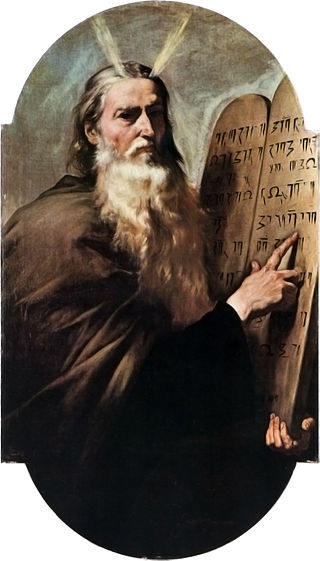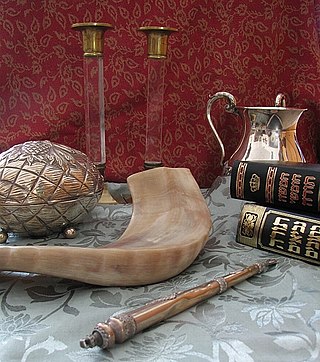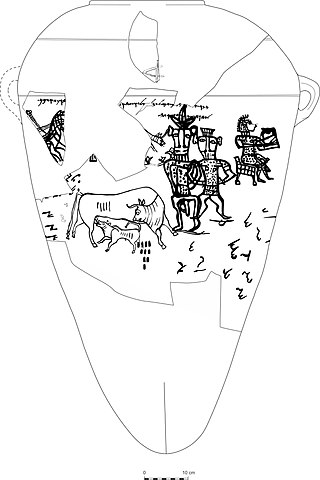External links
- Niels Peter Lemche, Conservative Scholarship–Critical Scholarship: Or How Did We Get Caught by This Bogus Discussion (September 2003)
Niels Peter Lemche (born 6 September 1945) is a biblical scholar at the University of Copenhagen, whose interests include early Israel and its relationship with history, the Old Testament, and archaeology. [1]
In 1971 Lemche received his undergraduate degree in theology at the University of Copenhagen, starting his long career at that institution. From 1972 to 1978 he worked there in various capacity until he was taken on as an associate professor. In 1985 he finished his doctorate in theology with a thesis on "Early Israel", a topic which has kept his interest for the last three decades. [2] In 1987 Lemche founded the Scandinavian Journal of the Old Testament with Knud Jeppesen, a publication he has been associated with to the present time as chief editor. [3] In 1987 he became Professor of Old Testament exegesis at the Faculty of Theology and served as vice dean of the faculty from 1993 to 1999. [2]
Lemche is closely identified with the movement known as biblical minimalism, and "has assumed the role of philosophical and methodological spokesperson" for the movement. [4]
Charles David Isbell sees Lemche as attempting to dismantle and discredit the "historical-critical" method of Old Testament scholarship. [5] Lemche himself writes that the 'so-called "historical-critical" school that created a universe of its own dubbed "ancient Israel" has dominated the last two hundred years of biblical studies.' [6] He argues that "ancient Israel" is the product of the Jewish community that was of "the Persian and especially Hellenistic and Roman periods". [7]
In common with the general trend of modern scholarship, Lemche identifies the Persian and Hellenistic period (5th century to 4th century BCE) as the most appropriate setting in which to seek the composition of the majority of the biblical texts, arguing that this is the single period that best explains the 'mental matrix’ for most Old Testament literature and "probably all of its historiography". [4]
Lemche considers the traditional narratives of Israel's history as contained in the bible to be so late in origin as to be useless for historical reconstruction. His alternative reconstruction is based entirely on the archaeological record, and may be summarized as follows: From at least as early as the first half of the 14th century BCE the central highlands were the habitation of the Apiru, "a para-social element ... [consisting] of runaway former non-free peasants or copyholders from the small city-states in the plains and valleys of Palestine," living as "outlaw groups of freebooters". When new settlements appear in the highlands over a century later, at the start of the Iron Age, they are evidence of new political structures emerging among those same groups. The Iron I settlements attest a return by those groups to a settled, agricultural lifestyle, and the beginning of a (re)tribalization process. Israel was the end-product of that process. Lemche's view has much in common with that of Israel Finkelstein. [8]

The Book of Joshua is the sixth book in the Hebrew Bible and the Old Testament, and is the first book of the Deuteronomistic history, the story of Israel from the conquest of Canaan to the Babylonian exile. It tells of the campaigns of the Israelites in central, southern and northern Canaan, the destruction of their enemies, and the division of the land among the Twelve Tribes, framed by two set-piece speeches, the first by God commanding the conquest of the land, and, at the end, the second by Joshua warning of the need for faithful observance of the Law (torah) revealed to Moses.

The history of ancient Israel and Judah begins in the Southern Levant region of Western Asia during the Late Bronze Age and Early Iron Age. The earliest known reference to "Israel" as a people or tribal confederation is in the Merneptah Stele, an inscription from ancient Egypt that dates to about 1208 BCE, but the people group may be older. According to modern archaeology, ancient Israelite culture developed as an outgrowth from the pre-existing Canaanite civilization. Two related Israelite polities known as the Kingdom of Israel (Samaria) and the Kingdom of Judah had emerged in the region by Iron Age II.

Yahweh was an ancient Levantine deity, and national god of the Israelite kingdoms of Israel and Judah. Though no consensus exists regarding the deity's origins, scholars generally contend that Yahweh emerged as a "divine warrior" associated first with Seir, Edom, Paran and Teman, and later with Canaan. The origins of his worship reach at least to the early Iron Age, and likely to the Late Bronze Age, if not somewhat earlier.

Canaan was a Semitic-speaking civilization and region of the Southern Levant in the Ancient Near East during the late 2nd millennium BC. Canaan had significant geopolitical importance in the Late Bronze Age Amarna Period as the area where the spheres of interest of the Egyptian, Hittite, Mitanni, and Assyrian Empires converged or overlapped. Much of present-day knowledge about Canaan stems from archaeological excavation in this area at sites such as Tel Hazor, Tel Megiddo, En Esur, and Gezer.

The Israelites were a group of Semitic-speaking tribes in the ancient Near East who, during the Iron Age, inhabited a part of Canaan.
The historicity of the Bible is the question of the Bible's relationship to history—covering not just the Bible's acceptability as history but also the ability to understand the literary forms of biblical narrative. One can extend biblical historicity to the evaluation of whether or not the Christian New Testament is an accurate record of the historical Jesus and of the Apostolic Age. This tends to vary depending upon the opinion of the scholar.

The Jebusites were, according to the books of Joshua and Samuel from the Tanakh, a Canaanite tribe that inhabited Jerusalem, then called Jebus prior to the conquest initiated by Joshua and completed by King David, although a majority of scholars agree that the Book of Joshua holds little historical value for early Israel and most likely reflects a much later period. The Books of Kings as well as 1 Chronicles state that Jerusalem was known as Jebus prior to this event. The identification of Jebus with Jerusalem is sometimes disputed by scholars. According to some biblical chronologies, the city was conquered by King David in 1003 BCE.
Idolatry in Judaism is prohibited. Judaism holds that idolatry is not limited to the worship of an idol itself, but also worship involving any artistic representations of God. The prohibition is epitomized by the first two "words" of the decalogue: I am the Lord thy God, Thou shalt have no other gods before me, and Thou shalt not make unto thee any graven image or any image in the sky, on earth or in the sea. These prohibitions are re-emphasized repeatedly by the later prophets, suggesting the ongoing appeal of Canaanite religion and syncretic assimilation to the ancient Israelites.

The Tel Dan Stele is a fragmentary stele containing a Canaanite inscription which dates to the 9th century BCE. It is notable for possibly being the most significant and perhaps the only extra-biblical archaeological reference to the house of David.
William Gwinn Dever is an American archaeologist, scholar, historian, semiticist, and theologian. He is an active scholar of the Old Testament, and historian, specialized in the history of the Ancient Near East and the ancient kingdoms of Israel and Judah in biblical times. He was Professor of Near Eastern Archaeology and Anthropology at the University of Arizona in Tucson from 1975 to 2002. He is a Distinguished Professor of Near Eastern Archaeology at Lycoming College in Pennsylvania.

The Omride dynasty, Omrides or House of Omri were the ruling dynasty of the Kingdom of Samaria founded by King Omri. The dynasty's rule ended with the conquest of Samaria by the Neo-Assyrian Empire under Shalmaneser V, who annexed the territory as the Assyrian province of Samerina.
Biblical minimalism, also known as the Copenhagen School because two of its most prominent figures taught at Copenhagen University, is a movement or trend in biblical scholarship that began in the 1990s with two main claims:
Thomas L. Thompson is an American-born Danish biblical scholar and theologian. He was professor of theology at the University of Copenhagen from 1993 to 2009. He currently lives in Denmark.

Mosaic authorship is the Judeo-Christian tradition that the Torah, the first five books of the Hebrew Bible/Old Testament, were dictated by God to Moses. The tradition probably began with the legalistic code of the Book of Deuteronomy and was then gradually extended until Moses, as the central character, came to be regarded not just as the mediator of law but as author of both laws and narrative.
The Bible in History: How Writers Create a Past,, is a book by Thomas L. Thompson, Professor of Old Testament at the University of Copenhagen. Its US title is The Mythic Past: Biblical Archaeology and the Myth of Israel.
"The Bible's Buried Secrets" is a Nova program that first aired on PBS, on November 18, 2008. According to the program's official website: "The film presents the latest archaeological scholarship from the Holy Land to explore the beginnings of modern religion and the origins of the Hebrew Bible, also known as the Old Testament. This archaeological detective story tackles some of the biggest questions in biblical studies: Where did the ancient Israelites come from? Who wrote the Bible, when, and why? How did the worship of one God—the foundation of modern Judaism, Christianity, and Islam—emerge?"

The origins of Judaism lie in Bronze Age polytheistic Canaanite religion. Judaism also syncretized elements of other Semitic religions such as Babylonian religion, which is reflected in the early prophetic books of the Hebrew Bible.

The siege of Jebus is described in passages of the Hebrew Bible as having occurred when the Israelites, led by King David, besieged and conquered the Canaanite city of Jerusalem, then known as Jebus. The Israelites gained access to the city by conducting a surprise assault, and Jebus was subsequently installed as the capital city of the United Kingdom of Israel under its initial name as the City of David.

Yahwism is the name given by modern scholars to the religion of ancient Israel and Judah. Yahwism was essentially polytheistic, with a pantheon of gods and goddesses. Heading the pantheon was Yahweh, the national god of the Israelite kingdoms of Israel and Judah, with his consort, the goddess Asherah, and second-tier gods and goddesses such as Baal, Shamash, Yarikh, Mot, and Astarte, each of whom had their own priests and prophets and numbered royalty among their devotees.
The composition of the Torah was a process that involved multiple authors over an extended period of time. While Jewish tradition holds that all five books were originally written by Moses sometime in the 2nd millennium BCE, leading scholars have rejected Mosaic authorship since the 17th century.